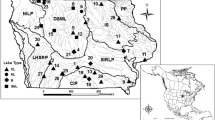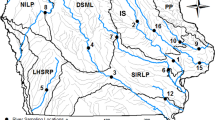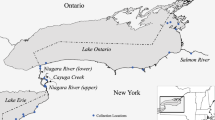Abstract
Mercury is a global pollutant that is released into our environment by natural and anthropogenic processes resulting in extensive studies of mercury cycling in aquatic ecosystems, and the issuance of human-health-based fish-consumption advisories. We examined total mercury concentrations in Walleye Sander vitreus from Upper and Lower Red Lakes, located in north central Minnesota, between 2019 and 2020. Sampled Walleye (n = 265) ranged from 158 to 610 mm in total length from an age range of young-of-the year to 16 years. Mercury concentrations within the Walleye ranged from 0.030 mg/kg to 0.564 mg/kg (x̄ = 0.179 ± 0.105 mg/kg; x̄ = mean ± sd, all fish-mercury concentrations expressed on wet-weight basis). The best supported model for predicting mercury concentrations in Red Lake Walleye included the independent variables: length, age, sex, and lake basin. This model indicated that there was a significant difference in mercury concentrations between Upper and Lower Red Lake (x̄ = 0.215 ± 0.117 and 0.144 ± 0.077 mg/kg, respectively), and also suggests that individuals who rely on fish for subsistence should target Walleye that are ≤ 400 mm from Lower Red Lake. Observed differences in mercury concentrations could be linked to wetland area influences, fish growth rates, and physicochemical parameters between the two basins. Given that our results illustrated a significant difference in fish-mercury concentrations between basins, future pollutant monitoring efforts should treat Upper and Lower Red Lake as separate lakes and not assume that data from one basin can apply to the other.






Similar content being viewed by others
References
Agency for Toxic Substance and Disease Registry (ATSDR (1999) Toxicological profile for mercury. US Department of Health and Human Services, Public Health Service, Atlanta, GA. Accessed 24 Mar 2019 https://wwwn.cdc.gov/TSP/ToxProfiles/ToxProfiles.aspx?id=115&tid=24
Bernhoft RA (2012) Mercury toxicity and treatment: a review of the literature. J Environ Public Health 2012:1–10. https://doi.org/10.1155/2012/460508. Accessed 21 Apr 2019
Brigham ME, Krabbenhoft DP, Hamilton PA (2003) Mercury in stream ecosystems-New studies initiated by the U.S. Geological Survey, 1–4. https://pubs.usgs.gov/fs/fs-016-03/. Accessed 14 Dec 2018
Brigham ME, Wentz DA, Aiken GR, Krabbenhoft DP (2009) Mercury cycling in stream ecosystems. 1. Water column chemistry and transport. Environ Sci Technol 43:1–6. https://doi.org/10.1021/es802694n. Accessed 18 Sep 2018
Brumbaugh WG, Krabbenhoft DP, Helsel DR, Wiener JG, Echols KR (2001) A national pilot study of mercury contamination of aquatic ecosystems along multiple gradients: Bioaccumulation in fish. Biological Science No. 2001–0009 USGS. http://pubs.er.usgs.gov/publication/bsr20010009. Accessed 9 Sep 2018
Burge DRL (2021) Managing the Red Lake Nation’s and Minnesota’s largest lake: Monitoring and paleolimnology support a site-specific standard for Upper and Lower Red Lakes (Red Lake Nation and Minnesota, USA). Modern Limnological and Paleolimnological Applications of Diatoms in Minnesota Lakes (Doctoral dissertation, University of Minnesota) 18–45
Chalmers AT, Argue DM, Gay DA, Brigham ME, Schmitt CJ, Lorenz DL (2011) Mercury trends in fish from rivers and lakes in the United States, 1969–2005. Environ Monit Assess 175:175–191 https://doi.org/10.1007/s10661-010-1504-6. Accessed 20 Oct 2018
Clayden MG, Lescord GL, Kidd KA, Wang X, Muir DCG, O’Driscoll NJ (2017) Using sulfur stable isotopes to assess mercury bioaccumulation and biomagnification in temperate lake food webs: Sulfur isotopes and mercury. Environ Toxicol Chem 36:661–670. https://doi.org/10.1002/etc.3615. Accessed 18 Sep 2018
Demers JD, Blum JD, Zak DR (2013) Mercury isotopes in a forested ecosystem: Implications for air-surface exchange dynamics and the global mercury cycle. Global Biogeochem Cycles 27:222–238. https://doi.org/10.1002/gbc.20021. Accessed 14 Nov 2018
Depew D, Burgess N, Anderson M, Baker R, Bhavsar S, Bodaly RA, Eckley C, Evans M, Gantner N, Graydon J, Jacobs K, LeBlanc J, St.Louis V, Campbell L (2013) An overview of Hg concentrations in freshwater fish species: a national fish mercury (Hg) dataset for Canada. Can J Fish Aquat Sci 70:1–16. https://doi.org/10.1139/cjfas-2012-0338. Accessed 13 Oct 2021
Eagles-Smith CA, Suchanek TH, Colwell AE, Anderson NL (2008) Mercury trophic transfer in a eutrophic lake: the importance of habitat-specific foraging. Ecol Appl 18:A196–A212. https://doi.org/10.1890/06-1476.1. Accessed 25 Oct 2018
Engstrom DR, Balogh SJ, Swain EB (2007) History of mercury inputs to Minnesota lakes: influences of watershed disturbance and localized atmospheric deposition. Limnol Oceanogr 52:2467–2483. https://doi.org/10.2307/4502395. Accessed 14 Dec 2018
Fitzgerald WF, Clarkson TW (1991) Mercury and monomethylmercury: present and future concerns. Environ Health Perspect 96:159–166. https://doi.org/10.1289/ehp.9196159. Accessed 19 Mar 2019
Fox J, Weisberg S (2019) An R companion to applied regression, 3rd ed. SAGE Publications, Inc, Thousand Oaks, CA. Accessed 31 Aug 2021. https://us.sagepub.com/en-us/nam/an-r-companion-to-applied-regression/book246125
Gabriel MC, Kolka R, Wickman T, Nater E, Woodruff L (2009) Evaluating the spatial variation of total mercury in young-of-year yellow perch (Perca flavescens), surface water and upland soil for watershed–lake systems within the southern Boreal Shield. Sci Total Environ 407:4117–4126. https://doi.org/10.1016/j.scitotenv.2009.03.019. Accessed 13 Nov 2020
Gilmour CC, Henry EA, Mitchell R (1992) Sulfate stimulation of mercury methylation in freshwater sediments. Environ Sci Technol 26:2281–2287. https://doi.org/10.1021/es00035a029. Accessed 25 Oct 2018
Goldman LR, Shannon MW, Committee on Environmental Health (2001) Technical Report: Mercury in the environment: implications for pediatricians. Pediatrics 108:197–205. https://doi.org/10.1542/peds.108.1.197. Accessed 21 Mar 2019
Hall BD, Aiken GR, Krabbenhoft DP, Marvin-DiPasquale M, Swarzenski CM (2008) Wetlands as principal zones of methylmercury production in southern Louisiana and the Gulf of Mexico region. Environ Pollut 154:124–134. https://doi.org/10.1016/j.envpol.2007.12.017. Accessed 4 Nov 2021
Harris HC, Rudd JWM, Amyot M, Babiarz CL, Beaty KG, Blanchfield PJ, Bodaly RA, Branfireun BA, Gilmour CC, Graydon JA, Heyes A, Hintelmann H, Hurley JP, Kelly CA, Krabbenhoft DP, Lindberg SE, Mason RP, Paterson MJ, Podemski CL, Robinson A, Sandilands KA, Southworth GR, St. Louis VL, Tate MT (2007) Whole-ecosystem study shows rapid fish-mercury response to changes in mercury deposition. PNAS 104:16586–16591. https://doi.org/10.1073/pnas.0704186104. Accessed 29 Jan 2022
Henderson B, Collins N, Morgan G, Vaillancourt A (2003) Sexual size dimorphism of walleye (Stizostedion vitreum vitreum). Can J Fish Aquat Sci 60:1345–1352. https://doi.org/10.1139/f03-115. Accessed 13 Oct 2021
Jeremiason JD, Engstrom DR, Swain EB, Nater EA, Johnson BM, Almendinger JE, Monson BA, Kolka RK (2006) Sulfate addition increases methylmercury production in an experimental wetland. Environ Sci Technol 40:3800–3806. https://doi.org/10.1021/es0524144. Accessed 13 Nov 2020
Krabbenhoft DP, Wiener JG, Brumbaugh WG, Olson ML, DeWild JF, Sabin TJ (1998) A national pilot study of mercury contamination of aquatic ecosystems along multiple gradients. U.S. Geological Survey Toxic Substance Hydrology Program-Proceedings of the technical meeting, Charleston, S.C., March 8–12, 1999. USGS Water-Resources Investigations Report 99-4018B, Vol 2, 147–160. https://pdfs.semanticscholar.org/8780/28e45ab5027ed861928eb0d2addca43fb387.pdf. Accessed 14 Dec 2018
Lamborg CH, Fitzgerald WF, Damman AWH, Benoit JM, Balcom PH, Engstrom DR (2002) Modern and historic atmospheric mercury fluxes in both hemispheres: global and regional mercury cycling implications. Glob Biogeochem Cycles 16:51-1–51–11. https://doi.org/10.1029/2001GB001847. Accessed 20 Oct 2018
Lemon J (2006) Plotrix: a package in the red light district of R. R-News 6(4):8–12
Lenth RV (2021) emmeans: estimated marginal means, aka least-squared means. R package version 1.6.2-1. https://cran.r-project.org/web/packages/emmeans/emmeans.pdf. Accessed 31 Aug 2021
Louis S, Rudd J, Kelly C, Beaty K, Bloom N, Flett R (1994) Importance of wetlands as sources of methyl mercury to boreal forest ecosystems. Can J Fish Aquat Sci 51:1–12. https://doi.org/10.1139/f94-106. Accessed 4 Nov 2021
Madenjian CP, Rediske RR, Krabbenhoft DP, Stapanian MA, Chernyak SM, O’Keefe JP (2016) Sex differences in contaminant concentrations of fish: a synthesis. Biol Sex Differ 7:1–16. https://doi.org/10.1186/s13293-016-0090-x. Accessed 4 Nov 2021
Mathers R, Johansen P (1985) The effects of feeding ecology on mercury accumulation in walleye (Stizostedion vitreum) and pike (Esox lucius) in Lake Simcoe. Can J Zool 63:2006–2012. https://doi.org/10.1139/z85-295. Accessed 13 Oct 2021
Minai M (2016) Methylmercury and human embryonic development. Embryo Project Encyclopedia 1–9. http://embryo.asu.edu/handle/10776/11335. Accessed 21 Mar 2019
Minnesota Department of Health (MDH) (2004) Eat fish often? A Minnesota guide to eating fish. http://www.health.state.mn.us/divs/eh/fish/index.html. Accessed 13 Oct 2021
Mitchell CPJ, Branfireun BA, Kolka RK (2008a) Assessing sulfate and carbon controls on net methylmercury production in peatlands: An in situ mesocosm approach. App Geochem 23:503–518. https://doi.org/10.1016/j.apgeochem.2007.12.020. Accessed 29 Jan 2022
Mitchell CPJ, Branfireun BA, Kolka RK (2008b) Spatial characteristics of net methylmercury production hot spots in peatlands. Environ Sci Technol 42:1010–1016. https://doi.org/10.1021/es0704986. Accessed 29 Jan 2022
Mitchell CPJ, Branfireun BA, Kolka RK (2009) Methylmercury dynamics at the upland-peatland interface: Topographic and hydrogeochemical controls: methylmercury at the upland-peatland interface. Water Resour. Res 45:1–12. https://doi.org/10.1029/2008WR006832. Accessed 13 Nov 2020
Monson BA (2009) Trend reversal of mercury concentrations in piscivorous fish from Minnesota Lakes: 1982-2006. Environ Sci Technol 43:1750–1755. https://doi.org/10.1021/es8027378. Accessed 3 Aug 2021
Monson BA, Staples DF, Bhavsar SP, Holsen TM, Schrank CS, Moses SK, McGoldrick DJ, Backus SM, Williams KA (2011) Spatiotemporal trends of mercury in walleye and largemouth bass from the Laurentian Great Lakes Region. Ecotoxicol 20:1555–1567. https://doi.org/10.1007/s10646-011-0715-0. Accessed 26 Jul 2021
Murphy GW, Newcomb TJ, Orth DJ (2007) Sexual and seasonal variations of mercury in smallmouth bass. J Freshw Ecol 22:135–143. https://doi.org/10.1080/02705060.2007.9664153. Accessed 13 Oct 2021
Myers GJ, Davidson PW (1998) Prenatal methylmercury exposure and children: neurologic, developmental, and behavioral research. Environ Health Perspect 106:841–847. https://doi.org/10.1289/ehp.98106841. Accessed 21 Mar 2019
Myrbo A, Swain EB, Johnson NW, Engstrom DR, Pastor J, Dewey B, Monson P, Brenner J, Shore MD, Peters EB (2017) Increase in nutrients, mercury, and methylmercury as a consequence of elevated sulfate reduction to sulfide in experimental wetland mesocosms. J of Geophys Res Biogeosci 122:2769–2785. https://doi.org/10.1002/2017JG003788. Accessed 19 Sep 2018
Ogle DH (2019) FSAdata: Fisheries stock analysis, datasets. R package version 0.3.8.
Ogle DH (2016) Introductory fisheries Analyses with R, 1st Ed., Chapman and Hall/CRC. 337. https://doi.org/10.1201/9781315371986 Accessed 15 Mar 2019
Ogle DH, Doll JC, Wheeler P, Dinno A (2021) FSA: Fisheries stock analysis. R package version 0.9.1. https://github.com/droglenc/FSA. Accessed 13 Oct 2021
Park J-D, Zheng W (2012) Human exposure and health effects of inorganic and elemental mercury. J Prev Med Public Health 45:344–352. https://doi.org/10.3961/jpmph.2012.45.6.344. Accessed 18 Mar 2019
R Core Team (2021) R: a language and environment for statistical computing. R Foundation for Statistical Computing, Vienna, Austria. https://www.R-project.org/. Accessed 18 Mar 2021
Rossi R, Murari A, Gaudio P, Gelfusa M (2020) Upgrading model selection criteria with goodness of fit tests for practical applications. Entropy 22:447. https://doi.org/10.3390/e22040447. Accessed 13 Oct 2021
Rustagi N, Singh R (2010) Mercury and health care. Indian J Occup Environ Med 14:45–48. https://doi.org/10.4103/0019-5278.72240. Accessed 18 Mar 2019
Rypel AL (2010) Mercury concentrations in lentic fish populations related to ecosystem and watershed characteristics. Ambio 39:14–19. https://doi.org/10.1007/s13280-009-0001-z. Accessed 20 Oct 2018
Scudder BC, Chasar LC, DeWeese RL, Brigham ME, Wentz DA, Brumbaugh WG (2008) Procedures for collecting and processing aquatic invertebrates and fish for analysis of mercury as part of the National Water-Quality Assessment Program. USGS Open-File Report No. 2008–1208, 1–46. https://pubs.usgs.gov/of/2008/1208/pdf/ofr20081208.pdf. Accessed 25 Mar 2019
Scudder BC, Chasar LC, Wentz DA, Bauch NJ, Brigham ME, Moran PW, Krabbenhoft DP (2009) Mercury in fish, bed sediment, and water from streams across the United States, 1998–2005. USGS, Scientific Investigation Report 2009-5109, 1-74. https://pubs.usgs.gov/sir/2009/5109/pdf/sir20095109.pdf. Accessed 9 Sep 2018
Shao D, Kang Y, Wu S, Wong MH (2012) Effects of sulfate reducing bacteria and sulfate concentrations on mercury methylation in freshwater sediments. Sci Total Environ 424:331–336. https://doi.org/10.1016/j.scitotenv.2011.09.042. Accessed 18 Mar 2019
Simoneau M, Lucotte M, Garceau S, Laliberté D (2005) Fish growth rates modulate mercury concentrations in walleye (Sander vitreus) from eastern Canadian lakes. Environ. Res 98:73–82. https://doi.org/10.1016/j.envres.2004.08.002. Accessed 20 Oct 2018
Smith Jr LL, Krefting LW, Butler RL (1952) Movements of marked Walleyes, Stizostedion vitreum vitreum (Mitchill), in the fishery of the Red Lakes, Minnesota. Trans Am Fish Soc 81:179–196
Snodgrass JW, Jagoe CH, Bryan Jr AL, Brant HA, Burger J (2000) Effects of trophic status and wetland morphology, hydroperiod, and water chemistry on mercury concentrations in fish. Can J Fish Aquat Sci 57:171–180. https://doi.org/10.1139/cjfas-57-1-171. Accessed 29 Mar 2019
Strandberg U, Bhavsar S, Parmar TP, Arts M (2018) Spatial and length-dependent variation of the risks and benefits of consuming Walleye (Sander vitreus). Environ Int 112:251–260. https://doi.org/10.1016/j.envint.2017.12.029
United States Environmental Protection Agency (US EPA) (2019) 2019 Toxics Release Inventory National Analysis. US EPA. https://www.epa.gov/trinationalanalysis/introduction-2019-tri-national-analysis. Accessed 13 Oct 2021
United States Environmental Protection Agency (US EPA) (2015) Clean Air Act Text. US EPA. https://www.epa.gov/clean-air-act-overview/clean-air-act-text. Accessed 18 Mar 19
United States Environmental Protection Agency (US EPA) (2007) Mercury in solids and solutions by thermal decomposition, amalgamation, and atomic absorption spectrophotometry. Method 7472, US EPA. https://www.epa.gov/sites/production/files/2015-07/documents/epa-7473.pdf. Accessed 25 Mar 2019
United States Environmental Protection Agency (US EPA (2001) Water Quality Criterion for the Protection of Human Health: Methylmercury. Office of Science and Technology, EPA-823-R-01-001, Washington, DC. Accessed 13 Oct 2021. http://www.epa.gov/waterscience/criteria/methylmercury/
United States Environmental Protection Agency (US EPA) (2000) Quality assurance project plan for analytical control and assessment activities in the national study of chemical residues in lake fish tissue. Report No. EPA-823-R-02-006.
United States Environmental Protection Agency (US EPA) (1997) Mercury study report to congress (Executive Summary No. EPA-452/R-97-003). US EPA. https://www3.epa.gov/airtoxics/112nmerc/volume1.pdf. Accessed 21 Mar 2019
Wang B, Zhong S, Bishop K, Nilsson MB, Hu H, Eklof K, Bravo AG, Akerblom S, Bjorn E, Skyllberg U (2021) Biogeochemical influences on net methylmercury formation proxies along a peatland chronosequence. Geochimica et Cosmochimica Acta 308:188–203. https://doi.org/10.1016/j.gca.2021.06.010. Accessed 29 Jan 2021
Wickham H, François R, Henry L, Müller K (2021) dplyr: a grammar of data manipulation. R package version 1.0.7. https://CRAN.R-project.org/package=dplyr
Xue J, Zartarian V, Mintz B, Weber M, Bailey K, Geller A (2015) Modeling tribal exposures to methyl mercury from fish consumption. Sci Total Environ 533:102–109. https://doi.org/10.1016/j.scitotenv.2015.06.070. Accessed 3 Aug 2021
Acknowledgements
A special thank you to Pat Brown, Herb Mountain, and Kevin Spears at the RL DNR and Tony Kennedy and his staff at the MN DNR, Bemidji Area Fisheries Office for allowing me to collect portions of Walleye samples for this study. Special thank you to Emily Rapp, intern and temporary RL DNR employee, Ola Cobenais and Jennifer Malinski (RL DNR) for assisting in the data collection and recording efforts. Bemidji State University for providing me the opportunity to obtain my Masters in Science degree. Mark Brigham (USGS) for finding equipment for my research and providing valuable feedback throughout this study. Dr. Jeff Jeremiason, Gustavus Adolfus College in St. Peter, MN, for training of what I could expect to see throughout my sample analysis. There were no additional funds received throughout the development of this manuscript.
Author information
Authors and Affiliations
Contributions
The research study and manuscript was prepared by the primary author, TO, as part of his Master’s research project. The co-authors supplied suggestions and edits throughout the research and formation of the manuscript before the first submission. All authors have read and approved the final manuscript.
Corresponding author
Ethics declarations
Conflict of interest
The authors declare no competing interests.
Ethics approval
This study was approved by the Red Lake Band of Chippewa Indians and Bemidji State University before any data was collected. Fish samples were obtain through experimental gill net assessments for fish population size. All fish within this study were euthanized in accordance to Red Lake Fisheries SOPs, however, this study did not require an ethics approval by any participating party.
Additional information
Publisher’s note Springer Nature remains neutral with regard to jurisdictional claims in published maps and institutional affiliations.
Supplementary information
Rights and permissions
Springer Nature or its licensor (e.g. a society or other partner) holds exclusive rights to this article under a publishing agreement with the author(s) or other rightsholder(s); author self-archiving of the accepted manuscript version of this article is solely governed by the terms of such publishing agreement and applicable law.
About this article
Cite this article
Orgon, T.J., Hafs, A.W., Isaacson, C.W. et al. Spatial and temporal variability of mercury in Upper and Lower Red Lake Walleye. Ecotoxicology 32, 811–823 (2023). https://doi.org/10.1007/s10646-023-02689-w
Accepted:
Published:
Issue Date:
DOI: https://doi.org/10.1007/s10646-023-02689-w




